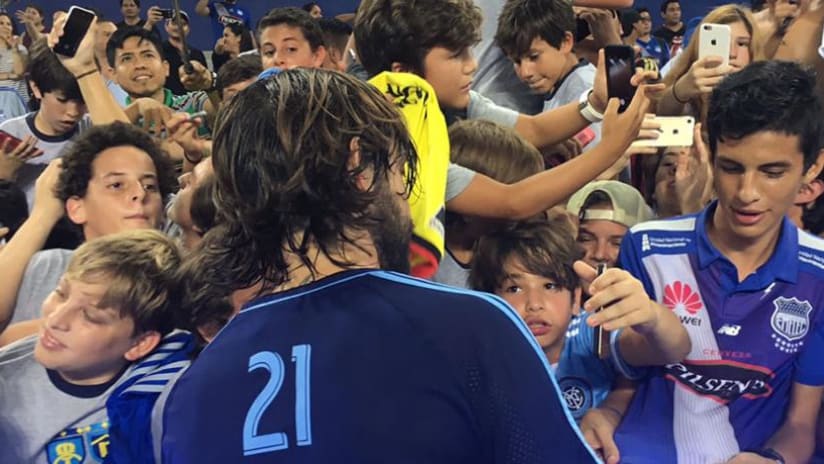New York City FC’s friendly against Ecuadorian club Emelec on Wednesday night was far from your normal preseason scrimmage.
NYCFC played Emelec to a 2-2 draw in front of a raucous crowd of 40,000 at Estadio George Capwell in Guayaquil – that’s not quite an afternoon runout in front of club staff in Tucson.
The huge crowd is the latest positive marker in a long and fruitful relationship between MLS and South America, one that’s featured a slew of South American players having a huge impact on the league, MLS teams participating in South American tournaments and clubs from both continents affiliating with each other.
Just how deep are the ties between MLS and South America? Read on to find out:
Players
South American players have played a huge role in Major League Soccer since the league began play in 1996, with Colombian Carlos Valderrama and Bolivians Marco Etcheverry and Jaime Moreno powering some of the best teams in the league in MLS’s early days.
The tradition of South American stars has carried on throughout the history of the league, with four different players from the continent winning an MLS MVP award and at least one South American earning a spot on the MLS Best XI in 18 of the league’s 21 seasons. Today, the league is littered with South American offensive talent, with players like the Portland Timbers’ Argentine attacker Diego Valeri, Seattle Sounders’ Uruguayan playmaker Nicolas Lodeiro and FC Dallas’ Argentine No. 10 Mauro Diaz among the best in MLS at any position.
In total, 67 players from nine South American countries were on an MLS roster last year, with that total likely set to rise with the addition of expansion clubs Minnesota United FC and South American-heavy Atlanta United FC in 2017.
Preseason Tours
Three MLS clubs are spending time in South America this preseason. NYCFC, of course, had their jaunt to Ecuador, while FC Dallas is currently in Argentina for a week-long camp and Columbus Crew SC opened their preseason camp with a lengthy trip to Sao Paulo, Brazil.
Traveling to South America for preseason training is nothing new for MLS clubs. Teams have been heading south for years for camps and scrimmages with local clubs, though that trend may have been a bit more frequent before annual trips to Tucson, Ariz. and Charleston, S.C. grew in popularity in recent years.
Affiliations/Partnerships
Several MLS clubs have affiliated with South American sides in past years. FC Dallas was affiliated with Brazilian side Club Atletico Paranaense, while the Chicago Fire had a partnership with Sport Club Internacional, also of Brazil. Nothing much ever came of either partnership, unfortunately.
Somewhat unsurprisingly, Orlando City SC are the only team currently with a South American partnership. The Lions are owned by Brazilian businessman Flavio Augusto da Silva, and in November announced a partnership with Paranaense.
Competitions
MLS teams have a limited amount of experience playing in South American competitions, as several teams participated in several different South American tournaments.
D.C. United has the most extensive experience of any MLS club playing in South American or intercontinental competitions, beating Brazilian team Vasco da Gama in the 1998 Copa Interamericana and participating in the 2005 and 2007 editions of the Copa Sudamericana. The only team in MLS history to participate in the tournament, D.C. were eliminated in the Round of 16 both times they played in the competition, which is one level below the continent’s premier tournament, the Copa Libertadores,
Two other MLS teams, Kansas City and the New York Red Bulls, participated in the Copa Merconorte tournament in 2001. Both clubs were eliminated in the group stage, with Kansas City actually getting stuck in Peru for a couple of days after playing a match there on Sept. 12, 2001, one day after the Sept. 11 terrorist attacks in New York City.
While no MLS team has participated in a South American competition in nearly 10 years, there has been some talk in recent years from South American soccer execs about inviting MLS sides to the Copa Libertadores. The tournament, which has regularly featured Mexican teams in the past, is widely regarded as the top club competition in the hemisphere and would be a difficult, taxing and potentially very rewarding environment for any MLS team that got the chance to play in it.










